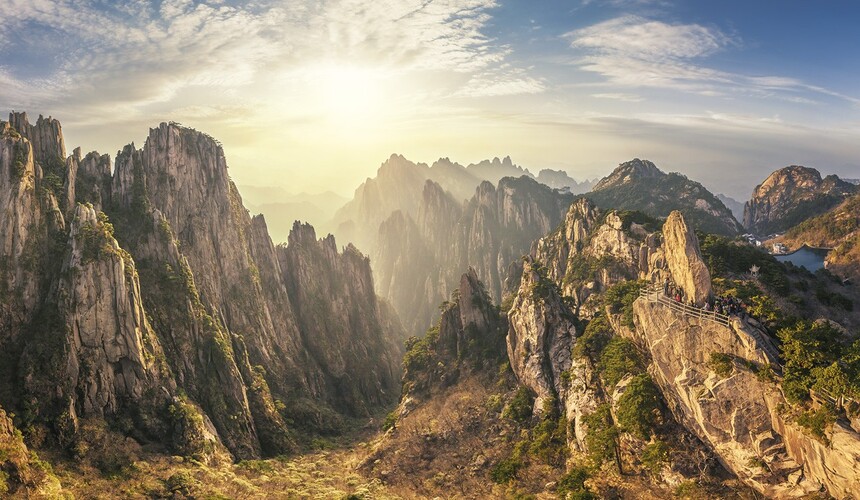
Explore the origination of Kung Fu – Luoyang, China
Luoyang, situated in west Henan Province, is the birthplace of Chinese civilization. Starting from the Xia Dynasty (21st-16th century BC), it used to be the capital city of 13 ancient dynasties. The city’s status as a World Heritage Site with the Longmen Grottoes located within its boundaries, and its proximity to the renowned Shaolin Temple. Make it a perfect destination to explore in central China. The city flower is the peony because poets and literati of ancient times often gathered there and left great works. To remind of this Luoyang host the ‘Poets Capital’ event in every April. This is the ideal city for those wishing to gain a deeper understanding of Chinese culture!
Attractions
Longmen Grottoes
The Longmen grottoes and niches house the largest and most impressive collection of Chinese art from the late Northern Wei and Tang dynasties (316-907). These works, which are entirely devoted to the Buddhist religion, represent the pinnacle of Chinese stone carving. The grottoes are distributed along the west and east banks of the river. The majority of the notable Buddhist carvings are located on the west side. However, a select few can also be viewed by crossing the bridge to the east side.

Luoyang Museum
The Luoyang Museum exhibition hall features a comprehensive display of Heluo Civilization artifacts and six specialized halls showcasing the history and culture of Luoyang through 15,000 priceless relics, including jade, bronze, pottery, stone sculpture, calligraphy, and painting. The Luoyang Museum houses a number of notable exhibits, including the Bronze Tripod Jue with the Pattern of Nipples, Stone Bixie, Tri-coloured Black Glazed Pottery Horse, White Jade Cup, and Jinsi Nanmu Pagoda. These five items are particularly noteworthy and are not to be missed.

Laojun Mountain
The site is situated two and a half hours’ drive to the south-west of central Luoyang. At an elevation of 2,217 metres, it is the highest point of the Funiu Mountains. Climbing and gondola rides are both available for visitors who wish to enjoy the spectacular mountain view, which features small waterfalls, green trees, and rocks of varying shapes. At the summit of the mountain, visitors will find a gilded roof pavilion. In addition to the impressive scenery, visitors can also explore the Jiguan limestone caves.

Luoyang Yingtian Gate
The Yingtian Gate was the southern entrance to the imperial palace in Luoyang during the Sui and Tang dynasties. It is thought to have been the largest city gate in ancient China. The base houses a museum which displays the ancient ruins of the Yingtian Gate. Following its reconstruction, the Yingtian Gate now serves as a city landmark, featuring a public square where citizens can visit and relax.

Mingtang Tiantang Scenic Area
The enormous pagoda and hall, recreated on the original site of the Ming and Tang palace complex, is a prominent feature of the area. Each structure is most impressive for its sheer scale. The Hall of Enlightenment features a sumptuous gilt throne room and a stage for daily belly-dancing performances. The basement floor of the Heavenly Hall offers visitors the opportunity to view the actual remains of the original structure. The top floor offers visitors an unparalleled view of the surrounding area.

Luoyang Tomb Museum
This excellent museum, which is not widely visited, has three main exhibits. These are: 20 reconstructed tombs, which span five main dynasties and over 1000 years, and which have been re-created using original building materials; original tomb murals; and a Northern Wei royal burial mound. A number of the relics from these tombs are held at the Luoyang Museum. Visiting the tombs first provides a valuable context for understanding the museum exhibits.

White Horse Temple
This extensive and dynamic monastery, situated just outside Luoyang, is widely regarded as China’s oldest surviving Buddhist temple. It was originally constructed in AD 68. In the Mahavira Hall, it is notable that the main sculpture is hollow and weighs only 5kg. The Shiyuan Art Gallery, which displays temporary exhibitions, is located at the rear of the complex, beneath a raised hall. Additionally, at the rear of the complex is a teahouse offering a refined ambience, an ideal venue for repose and refreshment with a modest cup of tea.

Shaolin Temple
The temple is renowned for its impressive kung fu displays, which feature the movements of animals, insects and even mythological figures. These performances attract martial arts clubs from across the globe, who make frequent pilgrimages to the temple.

Accommodation
Luoyang Marriott Hotel
The Luoyang Marriott Hotel faces Kaiyuan Lake and is backed by Xingluo Lake. Located on Luoyang Metro Line 2, only 3 km away from the Longmen High-Speed Railway Station and 17 km away from Luoyang Beijiao Airport, where leisure and business travelers can efficiently and quickly reach.

Travel tips
Q1: When is the best time to visit Luoyang?
A1: Autumn is the best travel season. The average temperature of Luoyang is about 15°C with pleasant weather.
Q2: How many days do I need to spend in Luoyang?
A2: 2 days is enough to have a tour of famous attractions including Longmen Grottoes, Shaolin Temple and White Horse Temple. If you have 3 days, you can explore deeper of Luoyang City such as Shaolin Kung Fu, join Luoyang Peony Festival, or take a side trip to admire Xiaolangdio or Laojun Mountain.
Q3: How can I travel to Luoyang?
A3: Domestic flights from other major cities will arrive at Beijiao Airport. There are two railway stations: Luoyang Railway Station and Longmen Railway Station.
If you would like to customize your own Luoyang itinerary, please contact one of our travel consultants!



